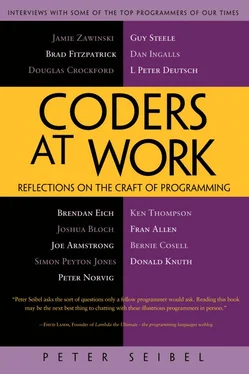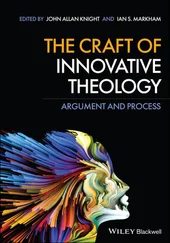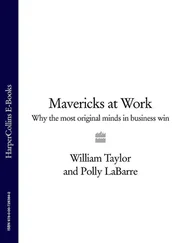Peter Seibel - Coders at Work - Reflections on the craft of programming
Здесь есть возможность читать онлайн «Peter Seibel - Coders at Work - Reflections on the craft of programming» весь текст электронной книги совершенно бесплатно (целиком полную версию без сокращений). В некоторых случаях можно слушать аудио, скачать через торрент в формате fb2 и присутствует краткое содержание. Жанр: Программирование, на английском языке. Описание произведения, (предисловие) а так же отзывы посетителей доступны на портале библиотеки ЛибКат.
- Название:Coders at Work: Reflections on the craft of programming
- Автор:
- Жанр:
- Год:неизвестен
- ISBN:нет данных
- Рейтинг книги:3 / 5. Голосов: 1
-
Избранное:Добавить в избранное
- Отзывы:
-
Ваша оценка:
- 60
- 1
- 2
- 3
- 4
- 5
Coders at Work: Reflections on the craft of programming: краткое содержание, описание и аннотация
Предлагаем к чтению аннотацию, описание, краткое содержание или предисловие (зависит от того, что написал сам автор книги «Coders at Work: Reflections on the craft of programming»). Если вы не нашли необходимую информацию о книге — напишите в комментариях, мы постараемся отыскать её.
Coders at Work
Founders at Work
Coders at Work: Reflections on the craft of programming — читать онлайн бесплатно полную книгу (весь текст) целиком
Ниже представлен текст книги, разбитый по страницам. Система сохранения места последней прочитанной страницы, позволяет с удобством читать онлайн бесплатно книгу «Coders at Work: Reflections on the craft of programming», без необходимости каждый раз заново искать на чём Вы остановились. Поставьте закладку, и сможете в любой момент перейти на страницу, на которой закончили чтение.
Интервал:
Закладка:
Steele:Well I did, in fact, print out the code on paper. I would sit at a desk and read it. And very often mark it up and make annotations and ask myself questions and things like that. And then I’d go back to the computer and start typing in things and see how it behaved. And tracing it.
Seibel:In this case you wanted to modify it, so that’s what you did. But could you get some benefit or enjoyment out of just reading the code? Print it out, read it, maybe scribble some questions on it, and then put it down?
Steele:Yes. If I had stopped at that point, it would have been a worthwhile exercise, just having read the code. It taught me something about VRML; it taught me something about JavaScript, which is that it doesn’t have as many abstractions as I would like. The dynamic typing was a little bit too freeform for my taste—in an object-oriented language.
Seibel:So let’s talk a little bit about designing software. You’re not coding as much these days as you used to, but how did you go about designing a new piece of software? Do you sit down at a computer and start coding or do you sit with a pad of graph paper, or what?
Steele:I’m being very cautious here because it’s all too easy to have a revisionist memory and say, “Oh, well, back in the ’70s this is the way I should have done it so that must be the way I did it.” I’m trying to remember actual things I did.
Sometimes I would draw flowcharts—I did have an IBM flowcharting template and pads of such paper. And I learned to program before the structured programming era, so some of my designs were structured and some of them weren’t. As I became aware of structured programming I recognized some of the good ideas in that and I think during the ’70s my assembly language programming became more structured in nature and I was thinking explicitly of making if/then/else paths and loops and things like that and I thought more about the structure of my assembly-language code.
I would often make lists describing the kinds of inputs I wanted to be able to give to a program and then write down a description of what kind of output I wanted. Or I would sometimes make up short examples. I recently found an example of one of the earliest APL programs that I ever wrote. I was probably 15 or 16 at the time. And what I had was a piece of APL code—this was the first thing I jotted down on paper before I’d actually tried it out. And enclosed was another piece of paper, which was an example of what I thought the input/output interaction would look like. It has bugs in it and doesn’t match the code and so forth but at least I was struggling to try to produce some examples of what I thought it would be like to use this program. It was exactly what I thought the terminal transcript would look like, on a printing terminal. Here’s a series of interactions that I think we can cause with this program.
Once I started working on the Maclisp project, that provided a structure. Nearly everything I did was a new function being added to an already existing large collection of functions. There were already plenty of examples of what documentation of functions ought to look like so it was just a matter of adding to that pile.
Seibel:You said you took over the interpreter from JonL, who had been doing both the interpreter and the compiler.
Steele:We’d collaborate on the design work. I was the junior member so he’d say, “Here’s a function we should have and here’s how it should work; why don’t you go code it.” Or, more often, we’d get requests from the Macsyma implementers saying, “We need something to do this,” and JonL and I would put our heads together and say, “Well, why don’t we design an interface that looks this way,” and I then would go off and code it.
Seibel:So those were new language features being added to Maclisp that had to be implemented in the interpreter and the compiler?
Steele:Yeah, language features. Many of a systems-oriented flavor—they needed to be able to control resources or allocate pages. I implemented a new data type called a “hunk,” which was probably the biggest disaster in language design we ever put in. It was essentially a cons cell with more than two pointers. It was a desperation move because we were running out of address space on the PDP-10. Recall that the 10 only had an 18-bit address space. In a list, 50 percent of the pointers were dedicated to just maintaining the structure of the list, whereas with a threaded set of hunks, maybe only one-eighth of the pointers were dedicated to the threading of the chunks so you’d get better memory usage that way.
Seibel:So you had this stream of requests for features—given that it was incremental, how did you maintain some kind of coherence? If you just keep adding one thing in the most obvious way, eventually you end up with a big pile of kludges that barely holds together.
Steele:There were one or two big reorgs. I think probably the most notable one was the complete redesign and reimplementation of all the input/output operations in the language. This was the so-called New I/O design, something I undertook in, I want to say, 1975 or ’76, somewhere in there. The goal was that the old I/O system allowed for only one input stream and one output stream, plus being able to interact with the console. We realized that it would be a lot more flexible if we could have actual Lisp objects that stood for I/O channels and then we could have as many as 15 I/O channels open.
The other thing that was pushing this was that Maclisp was beginning to be ported to other operating systems. Every site had its own variant of the PDP-10 operating system. When we looked at all the customers we had, we realized there were a half a dozen different operating systems we wanted to support: TENEX, TWENEX, ITS, TOPS-10, WAITS, and the CMU variant.
So there was a summer when I sat down with JonL and we designed a new set of APIs. We didn’t call them APIs at the time, but it was descriptions of functions that could be used to create file objects, open and close them, do things like “delete” and “rename” in a systematic way, and get directory listings.
Then there was a point where I took a fresh listing of all of Maclisp on paper and retreated to my parents’ summer home for a week with six sets of operating-systems manuals and the listing and spent six hours a day scribbling corrections and changes in the code.
I had to figure out for each feature, such as the “rename” function, how is that done, because the details of how you interact with the operating system to rename a file were very different among those six operating systems. But it tended to fall into three clusters—the TOPS-20 variants, the TOPS-10 variants, and ITS.
I spent a solid week doing that, and notice, doing design and implementation without sitting at a computer terminal. This was all desk work. And then after a week of that, I came back to MIT and spent the next month typing it all in and debugging and testing it.
Seibel:Why did you do it that way?
Steele:I did it that way because for every function I had to write, it would have to be preceded by an enormous amount of research. As I say, I’d have to read the specification for six operating systems. And I would have to spend an hour doing that and then write the 30 lines of code, probably times three. It didn’t seem to make sense to be sitting in front of a terminal when it wasn’t going to be buying me that much. It’s not as if I could Google something or access online documentation. I wasn’t spending most of the time typing. Better to use that desk space for the paper documents in front of me.
Читать дальшеИнтервал:
Закладка:
Похожие книги на «Coders at Work: Reflections on the craft of programming»
Представляем Вашему вниманию похожие книги на «Coders at Work: Reflections on the craft of programming» списком для выбора. Мы отобрали схожую по названию и смыслу литературу в надежде предоставить читателям больше вариантов отыскать новые, интересные, ещё непрочитанные произведения.
Обсуждение, отзывы о книге «Coders at Work: Reflections on the craft of programming» и просто собственные мнения читателей. Оставьте ваши комментарии, напишите, что Вы думаете о произведении, его смысле или главных героях. Укажите что конкретно понравилось, а что нет, и почему Вы так считаете.












